Selling Retail Price
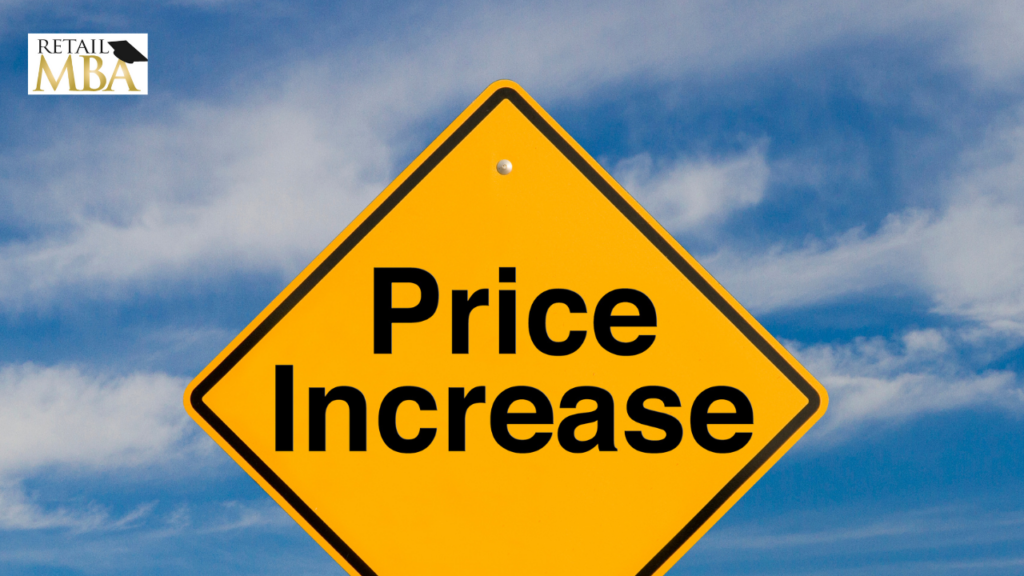
The Importance of Pricing for Retailers – Selling Retail Price!
Pricing decisions are of critical importance for retail managers. Achieve optimal pricing will ensure your business can secure its place in the market, attract customers, and give it scope for expansion and success.
Calculating retail selling prices requires using various methods, such as cost-plus, planned profit and contribution margin calculations.
Manufacturer’s Suggested Retail Price (MSRP)
Manufacturer’s Suggested Retail Price (MSRP) is the amount suggested by manufacturers as retail stores sell their product for. It may also be called the list or sticker price and provides manufacturers, distributors, and retailers with an understanding of a uniform market value for an item being sold while simultaneously making sure all parties involved in any given sales transaction remain profitable by its end.
MSRP pricing typically takes into account the costs associated with producing and marketing a product as well as expenses such as storage and shipping fees. Furthermore, manufacturers will conduct market research to assess what consumers are willing to pay for a given item so as to set an MSRP with sufficient profit margin.
Some retailers may choose to charge less than MSRP, a common practice when shopping for cars and other high-end purchases. This could be done to make more money or move inventory quicker; or as a strategy against competitors or online sellers. While this strategy might work in their favor, it can have long-term ramifications on brand image of their business.
An unfair pricing policy and could harm a brand’s reputation if a retailer offers prices lower than MSRP for certain products sold at retail. Furthermore, in certain jurisdictions it may even be illegal for them to sell at such low prices.
An additional factor when setting an MSRP is the dealer invoice price. This amount represents how much a dealer pays the manufacturer for the vehicle they sell; sometimes this figure can even exceed MSRP! Therefore, it is crucial that when negotiating with car dealerships that customers understand this difference. Furthermore, dealer invoice prices often include sales discounts or incentives offered directly by manufacturers that could ultimately influence final selling price to customers.
Cost of Goods Sold (COGS)
Cost of Goods Sold (COGS), also referred to as production expenses or overhead costs, refers to all of the expenses incurred by businesses in producing products that they then sell on. It includes costs such as raw materials, factory overhead expenses, direct labor and direct marketing costs but excludes indirect expenses like distribution and marketing. COGS provides a crucial metric that allows a business to calculate its gross margin – that portion of sales revenue retained after all expenses have been subtracted from revenue earned.
Calculating COGS can take many forms, depending on the needs of a business. A smaller company might only need to track it once every quarter while larger organizations might need to keep an eye on COGS for monthly or yearly calculations. It is important that calculations only include expenses directly related to producing and selling a product – this means leaving out selling, general and administrative (SGA) expenses such as office rent, accounting/legal fees or management salaries from this figure.
COGS (Cost of Goods Sold) is an essential metric for online retailers that allows them to assess whether their business is making a profit. Furthermore, this metric allows businesses to understand which products are performing well versus those which don’t sell so well, helping them tailor their pricing strategies appropriately.
Understanding changes to an inventory’s price affects its COGS is also helpful; for instance, an increase in cost will raise COGS levels; conversely if inventory decreases during any given time frame, its COGS should decrease accordingly.
Ecommerce businesses should understand both their COGS and gross margin to set prices that provide them with a healthy profit margin, and make informed decisions about which products to sell. They can also use this information when considering raising or lowering product prices.
Margin
Retail margin is defined as the percentage of total sales revenue that a retailer’s margin accounts for; it’s an essential metric in assessing whether a business is making money off their products. Margin levels differ among businesses depending on factors like their market positioning and pricing strategy, plus how much is spent to acquire goods from suppliers.
Margin and markup are often confused. Although both concepts are important, their calculation differs and each serves unique functions in your sales business. Finding the ideal formula to maximize profits on every sale and remain competitive will help your organization remain profitable in today’s marketplace.
The margin is the difference between a product’s wholesale and selling prices, and an important element of retail accounting, used to calculate gross and net profits of stores as well as compare competing companies. To calculate it, divide retail sales price by wholesale price then multiply it by 100.
Retail is all about high margins and maintaining them to be profitable, but it’s equally important to balance those margins against customer needs and demands. You might need to offer discounts to encourage buyers to purchase your items – this can help build brand loyalty and expand customer bases.
Note that margin does not account for costs like rent, utilities and labor; taxes; shipping/handling fees etc. Therefore it’s vitally important to monitor changes to margin and monitor its changes over time.
Implement these strategies to increase your profit margin. Utilize new technologies to streamline processes and cut manual tasks can help your business run more efficiently – this allows for a higher profit margin without compromising quality or customer service. Also consider offering innovative new products as a means of driving sales and expanding customer bases – ASD Market Week has an amazing selection of high-margin merchandise you should check out.
Step-by-step training on how to sell to retail chains!
We explain exactly how to do that and how to get started today. I’ve taught over 100,000 of companies over the years across the globe on how to get your products to the stores. And so we’re here to support you. Or please subscribe to our Youtube channel and or be on the lookout for additional training that we create.
We are here to expedite the process of generating revenue with your physical products and that’s what we’re all about. Take a look at our advanced training, live events, certification programs and so much more.
In this training, I will discuss some of the things to think about when approaching a retailer to sell your products and become a vendor. Hope it helps! 🙂
Karen Waksman,
Retail MBA
Questions? Contact Us!
1-855-Retail-2 (Call or Text)
Email: info@retailmba.com
Retail MBA provides a step-by-step formula on How to Sell to Major Retailers, Online Retailers, Smaller Retailers, Catalogs and More. No Experience Required! These solutions continue to convert for clients year-over-year! These are Time-Tested and Proven Strategies that we utilize ourselves when going after stores! Everything we teach, we test. Want access to these formulas? ANY one of our programs and coaching systems gives you access to them now. With that said…
Here are 5 Easy Ways to Work with Us:
1) Free Training – If You Would Like to Join Our Next FREE Webinar Training Called “Retail Chain Store Secrets – How to Sell to Major Retail Chains. No Experience Required” Then Sign Up NOW To Learn All About Selling into Retail Chains By Clicking Here!
2) Retail MBA Year Long Coaching and Training System – Our Year Long Coaching and Training System with Karen Waksman is POWERFUL! This is our most popular training and coaching system! We walk you through how to approach, pitch and sell to retail chains and we coach you along the way! Join us by Clicking Here!
3) Masterclass Intensives – Want to Join our Next 4 Week Elite Retail MBA Masterclass Intensive? These Intensives Are EPIC for people who Love Fast Paced Learning – Homework, Retail Coaching, Developing Your Strategy, Buyers Contacts and More! These Events Are Held Every Quarter. Join us by Clicking Here!
4) Done-for-You Program – If You Want Karen Waksman and Her Team to Reach Out to Your Top Dream Retail Chains On Your Behalf – And You Have a Retail-Ready Product, Check Out our Epic Done-For-You Service by Clicking Here!
5) In Person Events – If You Want to Learn LIVE and Meet Karen Waksman in Person at Our Next “America’s Next Retail Product: LIVE Event with Other Like-Minded Individuals in Beautiful San Diego, CA! We Would LOVE to Have You Join Us by Clicking Here!
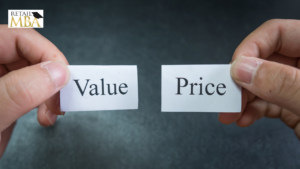
Check Out Our Additional Blog Posts Here:
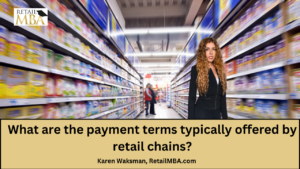
Retail Terms
Retail Terms – What are the payment terms typically offered by retail chains? Click Here to Learn More!
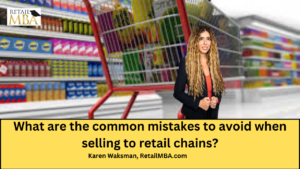
Retail Vendor
Retail Vendor – What are the common mistakes to avoid when selling to retail chains? Click Here to Learn More!
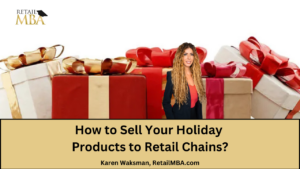
How to Sell Your Holiday Products to Retail Chains
New Training on How to Sell Your Holiday Products to Retail Chains
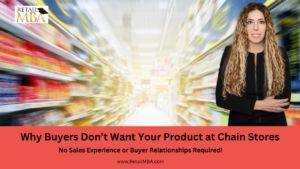
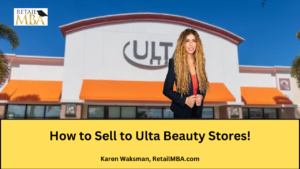
Ulta Beauty Vendor
Ulta Beauty Vendor – How to Sell to Ulta Beauty Stores. Click Here to Learn More!
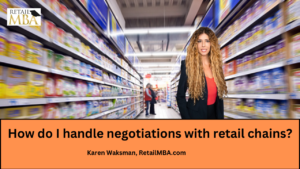
Retail Strategy
Retail Strategy – How do I handle negotiations with retail chains? Click Here to Learn More!
